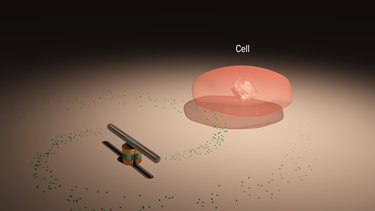Researchers Create World's Fastest, Smallest Nanomotor
By Joel Lindsey

A team of researchers at the University of Texas at Austin’s Cockrell School of Engineering has created the world’s smallest and fastest nanomotor, which developers say could provide a more effective way to deliver drugs to patients with certain conditions.
“We were able to establish and control the molecule release rate by mechanical rotation, which means our nanomotor is the first of its kind for controlling the release of drugs from the surface of nanoparticles,” Donglei Fan, assistant professor of mechanical engineering and lead researcher on the project, said in a press release published recently on the university’s website. “We believe it will help advance the study of drug delivery and cell-to-cell communications.”
The research team built the nanomotors using a patent-pending technique invented by Fan while studying at Johns Hopkins University. The team reported that the device’s dimensions are all less than 1 micrometer, making it small enough to fit inside a human cell. It can rotate at a speed of 18,000 RPMs — as fast as a jet engine — for as long as 15 continuous hours. Up until now, nanomotors typically rotated at a speed of between 14 and 500 RPMs, for a duration of somewhere between a few seconds and a few minutes.
During early tests of these newly created microscopic devices, researchers found that the nanomotors were capable of rapidly mixing and pumping biochemicals as well as moving through liquids. Both capabilities could make the nanomotors important components in future drug delivery techniques and devices.
“To test its ability to release drugs, the researchers coated the nanomotor’s surface with biochemicals and initiated spinning. They found that the faster the nanomotor rotated, the faster it released the drugs,” the press release explained. “The researchers [also] found that they could position the nanomotors in a pattern and move them in a synchronized fashion, which makes them more powerful and gives them more flexibility.”
At this point, researchers involved with the project indicate that the nanomotors could be most effective in powering nanomachines for the controlled delivery of insulin to diabetics, as well as in treating cancer cells in a way that would avoid damaging any nearby healthy cells.
Details regarding the capabilities of the new nanomotors and their performance in initial tests have been published in an article featured in the journal Nature Communications.
Image Credit: Cockrell School of Engineering at The University of Texas at Austin
